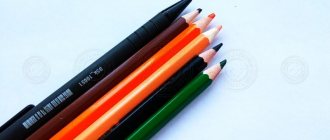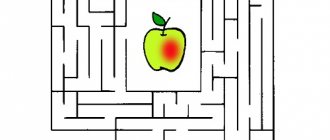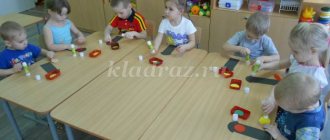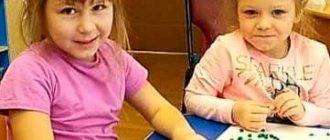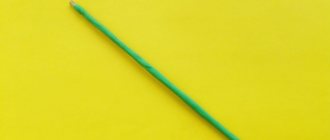According to Maria Montessori's periodization of development, the peak of activity in a variety of directions occurs in children precisely at the age of 2 to 3 years. Kids actively master speech and movement, learn to interact with a variety of objects, learn patterns and become sensitive to order, and also begin to expand their circle of acquaintances and make their first friends.
All this means that it is at this age that it is important to arrange for children all kinds of activities and games for harmonious development.
The motto of the Montessori philosophy is: “Help me do it myself.” The task of adults is to inspire children to make independent discoveries and achievements, because our little ones can do much more than it seems at first glance.
When planning Montessori activities for children 2-3 years old, you should adhere to the following rules:
- Classes should be aimed at increasing the child’s independence,
- Use different senses
- Include elements useful for the development of fine and gross motor skills,
- Take into account the interests of the child and use only at his request,
All Montessori activities should be presented to the child in advance, located in a place accessible to him (on a low shelf) and be accessible without the help of adults (however, exercises with small objects should be offered only when you have time to monitor the baby).
Montessori classes to develop a sense of order for children 2-3 years old
Such exercises help the child understand the principles by which our world exists; mainly here we work on sorting and classification.
Find a pair - Montessori classes for 2-3 years old
The principle of pair selection can be very widely used in working with children:
- Invite your child to sort his own socks and gloves.
- Print out images of animals and offer to compare the picture with existing toy models (the same can be done with your favorite cars, flowers, building models, etc.)
- Offer to find paired cards (colors, images, textures),
- Use special Montessori materials for 2 years and older
Sorting – complicated Montessori games for children from 2 years old
When the baby has mastered pairs, you can move on to a more complex option - sorting.
- Sort cards of different shades by color (you can cut pictures from magazines, scraps, colored cardboard, or you can buy a ready-made Montessori set),
- Remember Cinderella and offer to sort out different types of cereals. First, it is better to take larger grains: beans, chickpeas. Children's breakfast cereals with their cereals, pillows and rings can also be convenient,
- Sort out the box with grandma's buttons by shape, color or number of holes (you definitely have one!)
- Ask your child to put the cutlery in its place,
- Offer to clean up the kitchen and put all the cylinders and balls in one direction, and the cubes and parallelepipeds in the other,
- Rewind the salad: cucumbers to cucumbers, tomatoes to tomatoes, and so on
Establishing Montessori Sequences for a Child 3 Years and Under
- Lay out cards with simple stories and ask your child to remember the correct sequence of events.
- Use Montessori cylinders to help your child master the concepts of less-more and lower-higher,
- Learn simple self-care steps, breaking them down into steps. This way you can learn how to brush your teeth, take a shower, care for animals, and get ready for kindergarten.
Abstract of the educational activity “Our favorite kindergarten” for the younger group
Abstract of the educational activity “Our favorite kindergarten” for the younger group
Educational area:
“Social communicative development”
Goal:
To form children’s knowledge about the world around them;
Objectives: Educational:
• Formation of readiness for joint activities with peers and adults, • Formation of social and communicative speech skills.
Developmental:
• Develop friendly relations in children towards kindergarten, • Development of cognitive activity;
• Develop the child’s emotional sphere, speech, thinking, memory. Educational:
• Cultivate positive emotions that create a cheerful, cheerful mood.
To form a feeling of sympathy for peers, a friendly attitude, and a willingness to respond to the request of an adult - teacher. Preliminary work:
Reading works of fiction about the rules of behavior in kindergarten, about friendship, looking at illustrations: “We are in kindergarten”, didactic games: “Emotions”, “Locomotive of Emotions”;
conversations: “We are friendly guys”, “What is kindergarten?” Expected result: Children will develop a positive attitude towards kindergarten, difficulties in communicating with adults and peers will be overcome. Org. Moment Educator:
(
invites the children into the circle)
I recognized all the children I called you into the circle with me We will all hold hands and smile at each other To make it more fun
Pass on the mood quickly (the teacher smiles in the mirror, the children pass the mirror around with a smile) Educator :
— “You and I shared a good mood with each other, let’s smile at each other.”
While a song about kindergarten is playing, the teacher brings the Bouncing Bunny toy into the group. (The teacher speaks for the Bunny) Bunny:
“Hello, kids!
I'm the Bouncing Bunny. Tell me, please, where did I end up?” Children:
This is a kindergarten.
Bunny:
“Kindergarten, what is kindergarten?
And what is it for? (Photo of the kindergarten) Educator:
- “Guys, let’s help Bunny find out what a kindergarten is?”
Children:
Children's answers
Main part
Educator:
“Whoever finds it.
Where is the photo of the kindergarten in our group?” - Children search on their own (Sit the children in a semicircle on chairs. Place a bunny. Magnetic board with illustrations about the kindergarten) Educator:
draws the children’s attention to a photograph of the kindergarten - What kind of building is this?
– Children’s answers: “Kindergarten” - How many floors does it have? – Children’s answers: “Two” – Who goes to kindergarten? – Children’s answers: “Children, teachers” – Why do you guys come here? – Children’s answers: “Play, eat, sleep, walk.” Educator:
“Well done guys, now Bunny knows what kindergarten looks like.
And what do children do in it?” Didactic game in a circle: “Let’s get to know each other”
Bunny:
“I also really like to play, and I know a very interesting game called “Let's get to know each other.”
Bunny:
“Guys, I suggest everyone hold hands and line up in a circle” - the teacher helps to line up in a circle, he himself stands up with the toy bunny.
Bunny:
I'll run around in a circle and extend my paw. Whoever says his name will shake my paw.
The teacher with a toy in his hands walks around the children, hearing the child’s name, he repeats it out loud and adds: “It’s very nice (child’s name) I’m a Jumping Bunny.”
Bunny:
“I was very pleased to meet you,” he asks a question, addressing the children: “I want to ask you, the most interesting thing in kindergarten is playing and is there nothing else you do?”
(children’s assumption) Teacher:
“Bunny, the guys will tell you and show you what interesting things we are still doing.”
Bunny:
(addresses the children) “What interesting things can you do with those objects over there, and what are these objects?
- points to the cubes" Children:
"These are cubes, they are needed for construction."
The teacher motivates the children to independently construct with an explanation from the cubes.
Choice of building according to the children's wishes .
Bunny:
“What wonderful toys the blocks are.”
“You can use cubes to build and construct different structures.” Educational game: “Colored Rain” - in pairs Cards with colored clouds of red, yellow, green, blue according to the number of pairs of children Bunny:
Pays attention to the pencils in the cups and asks the children: - “What are these beautiful sticks, what are they for?”
(children's answers) Children:
“These are pencils, they are needed for drawing.”
Educator:
“That’s right, these are colored pencils, you can draw anything with them.” I suggest everyone choose a pair and, to the music, draw colorful rain that comes from different colored clouds.
- From the blue cloud, what kind of rain will come? - blue; - From the red cloud? - red; etc. They pronounce all the colors, do the work independently to the music, the teacher draws with the children and the teddy bear, put all the cards in a row
Bunny:
“What a beautiful multi-colored rain, how we made it” - the children’s answers: “Drawn with pencils.”
Mishka draws attention to the corner of cognition, counting materials: ducks, dogs, nesting dolls.
Bunny:
“Why do you need so many identical toys?”
Educator:
“With the help of them we learn to compare objects.” - What kind of duck is this? – big. - What kind of duck is this? - small. - It’s also interesting to count them, guys, what should we count? – children voice their choice, count: “One, two...”
Bunny:
“You guys are great at counting and you taught me”
Experimental activity: “Boats” (Container with water, paper boats) Educator:
“We love to build, draw, count, and it’s also very interesting to solve riddles and conduct experiments and experiments " - addresses the children: - How to make a boat float on the water without the help of hands?
-What can be done? - children’s suggestion to blow on the boats (children blow on the boats on their own, making them float, the bunny blows on the boats with the children.) Bunny:
“Guys, I haven’t solved the riddle, why did the boats sail?”
- children’s answers: “We blew on the boats, created the wind that made them sail” - (the teacher helps formulate the conclusion.) Didactic game: “Find the book”
Bunny:
“I’m interested in so much knowledge, where can I get it?”
Educator:
“Knowledge can be obtained from books”
Bunny:
“I don’t know what books are, show me guys” - children show the book corner - There are a lot of books, but you probably don’t have books about kindergarten.
Educator:
Children, show a book in which it is written about kindergarten (children find the one they need among the laid out books)
Educator:
Well done, there are different books, with the help of this book we will learn about the rules of behavior and the daily routine in kindergarten.
Bunny:
“Please tell me what the daily routine is in kindergarten”
Phys.
minute: “Kindergarten” Early in the morning we came, (walking in place) And everyone started playing, So that health was in order one, two, one, two We do morning exercises We wash our hands with water, before eating (imitate hand washing) Then we will learn a lot of useful, smart and interesting things, and then quickly go for a walk and play on the playground. We need to return from a walk once, twice, once, twice. Eat lunch together in peace. After sleep, go to bed sweetly. In very soft beds. For health and order, we need invigorating exercises. One, two. One, two, wake up kids; And then a game awaits us, this is how the kids live here (sit on the carpet)
Bunny:
“You guys have a very interesting time in kindergarten.”
Bunny:
“What a fine fellow you all are, already accustomed to kindergarten, to each other, but there are so many of you, you probably swear very often, fight, take away each other’s toys”;
Children:
Children's answers (if there is a difficulty, the teacher helps)
Educator:
“Bunny, we learn to be friends with the help of poems, stories, games, songs”
Educator:
I suggest everyone hold hands and make a circle of friendship
Children sing a song: “The sun has friends “
The sun has friends, it’s us, you and me. It’s good when friends are us, you and me! -2 times
Bunny:
“What a beautiful and kind song, I also want to become your friend,” he addresses the children, “will you be friends with me?”
— children’s answers RESULT
Little Bunny: “It’s time for me to go back to the forest and tell you about your kindergarten. Please remind me guys what I should tell you.” 1) Today you told me about what? – about kindergarten 2) Who goes to kindergarten? – children, teachers; 3) What do children do in kindergarten? - play, dance, sing, sleep... 4) How do children play in kindergarten? - amicably
Bunny:
“Thank you guys, you’re all so great, now I remember everything, and I’ll quickly run into the forest so as not to forget.” That’s what kind of friends we are, I’m very happy with everything, And now it’s time for me to go to the forest, Goodbye kids!
- the children say goodbye to the bunny. Educator:
“Guys, I also want to tell you that you all did great today, you answered well and worked together.
Montessori classes for the development of fine motor skills for 2-3 years
Little hands still don’t obey as well as adults, but finger coordination is the key to brain development. That is why fine motor skills are given great attention in preschool pedagogy.
Simple lacing is an excellent Montessori activity for children aged 2 years and older.
- Did your parents buy new shoes? First, ask your child to sort out the lacing. Children's shoes may be too small to be familiar with laces, so older ones may help.
- You can purchase a beautiful Montessori set for mastering lacing,
- Make beads or a bracelet from cord and large wooden beads,
- Master weaving craft with your child: weave a rug from large scraps, or maybe you have enough patience for a whole bag,
Pouring water and playing with small objects - Montessori activities that delight children 2-3 years old
- Don't be afraid to encourage children to pour their own water from the jug. Yes, perhaps several glasses will end up on the floor, but after a couple of times the baby will master this task without any problems and will be able to maintain the drinking regime himself (do not forget to offer the child a rag or mop in case water spills),
- Make the most of bath time: children can spend hours fiddling around in the bathtub with molds and toys, and this activity is extremely beneficial for their development,
- Pour small cereal into a bowl, give the child a spoon or scoop and offer to pour it into another container (the width of the neck will determine the difficulty of the whole activity),
- Invite your child to sort small objects (coins, pom-poms, peas, shells or pebbles) using tweezers,
Lesson notes. All notes - Notes of educational activities for children 2–4 years old “Bunny’s Birthday”
Publication “Summary of educational activities for children 2–4 years old “Birthday...”
LESSON SUMMARY IN A MIXED AGE GROUP (from 2 to 4 years old) “BUNNY’S BIRTHDAY” Objectives To develop children’s spoken language as a means of communication and knowledge of the world around them. Develop the ability to perform dance movements to music, enriching children's musical experience. Pin...
Summary of the lesson on the FCCM “My native village of Ibragimovo.” Second junior group Goal: developing a basic understanding of the pupils about their small Motherland. Tasks: 1) continue to teach children to name their hometown. Give a basic idea of your hometown; 2) develop speech and memory in children; 3) cultivate love for one’s native village. Preliminary…
Theatrical activities with children 4 years old based on the fairy tale by V. Suteev “Under the mushroom” SCHEME OF PERSPECTIVE PLANNING OF TARGETED WORK ON THEATERIZATION OF A LITERARY WORK WITH CHILDREN 4 YEARS OLD ACCORDING TO THE TALE BY V. Suteev “UNDER THE MUSHROOM” The work is designed for 1.5. First stage: 2 weeks. Second stage: 2 weeks. Third stage: 2 weeks. Stage Purpose of work Work on…
Plan-summary for FEMP in the second group of early age “Journey to the Magic Forest” Plan-summary for the cognitive development of FEMP in the second group of early age on the topic “Journey to the Magic Forest” Developed by: Lukina Elena Nikolaevna teacher of the second junior group Lesson topic: “Journey to the magical forest" The purpose of the lesson is to consolidate the knowledge passed...
Introducing literacy and mathematics - interesting Montessori activities for children 3 years old
If your child is already starting to show an interest in letters and numbers, the games presented below can be a great start to learning to read and write.
- Create letter and number bags filled with cereal and other fillings. With the help of these bags you can look for the first letters in words and come up with different games that introduce your child to phonetics,
- Make a couple of sets of cards with letters and numbers and use matching tasks,
- For learning to write, reusable outlines of letters can be useful; they can be traced with finger paints, plasticine and, when the hand is ready, with a pen,
- You can also make images of letters and numbers with a rough surface: this can be done with glue and sand. So the child will quickly remember the outlines of the symbols,
- Sets are great for learning to count, where you can select the required number of objects or dots for each number. This is necessary so that the child understands the meaning of numbers from the very beginning.
Development of the senses through Montessori activities at 2 years and older
- Collect objects of different sizes, shapes and textures in an opaque bag and invite your baby to recognize them by touch.
- Get musical instruments and Montessori sound cylinders: teach your baby to feel the rhythm and pitch of sound, offer to choose pairs, distribute sounds in order,
- An excellent exercise for the development of visual analyzers will be the free work of children with creative materials: gouache, finger paints, watercolors, colored sand, plasticine,
- Sometimes you can find slimes and all kinds of jellies in children's stores; they can also be used to diversify the sensory experience.
Montessori games for 2 years old to gain independence at home
These exercises should rather be called a rational organization of space for children, which will help them master all the actions of caring for themselves and their things as quickly as possible:
- Help your child learn to dress independently: you can hang a funny diagram on the wall, you can make stickers on clothes and shoes that will help the child find the right side,
- Place on one tray everything you need to tidy yourself up when you wake up and before bed: comb, toothbrush, toothpaste, glass of water. Let the baby use all these items himself first, and then, if necessary, provide assistance.
- Some particularly stubborn fasteners can be attached to a work surface and create a kind of busy board on which the child can practice skills, so that later buttons and zippers do not cause problems for the child,
- At the same age, it is worth teaching your child to wash his hands with soap correctly; hang a reminder on the door or choose a rhyme that will remind the child to wash his hands after going outside and using the toilet.
According to the Montessori method, children aged 2 years can begin to be assigned general household chores.
- Teach your child how to use a spray bottle and offer to wipe the windows (make sure they are securely closed!) or the mirror. Make sure that your child does not come into contact with aggressive household chemicals,
- At the same age, you can teach your child to wash dishes - first, just rinse plates and cups in water, and then use a sponge,
- Sorting laundry is a great task for children: ask your little one to separate whites from colours, cottons from wool, or simply distribute the laundry into several baskets,
- The baby can start setting the table for himself. To learn the location of cutlery and utensils, you can offer your child a special rug with silhouettes, it will also protect the table from dirt,
- Allow your child to participate in making your home cozy: let him put flowers in a vase, put away pets’ bowls, sweep the floor with his own small broom, arrange photo frames,
- It is useful for the development of gross motor skills to invite the child to lay out the carpet every time he wants to play on the floor, and to roll it up when the game is finished. Make sure that the mat is not too heavy for the child.
Junior group. Early childhood, nursery. Children 1-4 years old
Summary of didactic games in the early age group “Modes of Transport”
Goal: to introduce children to various types of transport, to increase the vocabulary of each child. Objectives: · To form ideas about various types of transport: water, land, air; ·Teach to follow traffic rules; · Develop skills of careful...
GCD for cognitive development “Clothing and footwear” (junior group) Program content: Educational objectives: learn to classify clothing and footwear; exercise the ability to correlate geometric shapes of a certain color with “holes”
on clothes; enrich vocabulary; Developmental tasks: develop attention, memory, speech; Educational…
conclusions
The Montessori method for children from 2 years old offers a huge selection of activities and allows you to adapt to the interests and character of each child. For the harmonious development of the baby, try to offer your child activities from different blocks, and also make sure that the child always has a choice of what to do.
Any tasks proposed here can be adapted to suit any child. An active fidget can be asked to run around the entire yard in search of objects on cards, and a slow homebody can from time to time make the task easier and bring materials in a basket. A technology lover will find it more interesting to find pairs for cars of different colors, and a wildlife lover will be happy to work on sorting images with animals and plants.
Always make sure your child is satisfied and never force you to complete tasks. Only thanks to internal motivation will the child’s cognitive and emotional development develop successfully.
